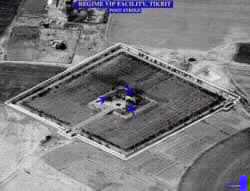Republican Guard and other Iraqi troops regrouping in Saddam Hussein's hometown, Tikrit, have been battered by U.S. air strikes and don't present an effective fighting force, U.S. Central Command said Friday. Planners said some Iraqi troops may already have fled. The planners are raising the possibility that Tikrit - long touted as the possible site for a last stand by Saddam's loyalists - may fall without much of a fight.
After the peaceful handover of Mosul and Kirkuk, Tikrit is the next big prize in northern Iraq. The city was the Iraqi president's power base during his rule and was the source of many members of his inner circle.
Izzat Ibrahim Believed to be in Charge of Tikrit Defense
Planners are not ruling out a battle for Tikrit. One of Saddam's longtime confidants, Izzat Ibrahim al-Douri, is believed to have moved missiles into the Tikrit area to bolster its defenses.
U.S. officials have seen remnants of Republican Guard and other Iraqi army units join up with other stragglers in and around Tikrit, making what some refer to as "composite forces" still defending the city, about 90 miles northwest of Baghdad.
Vehicles and other military equipment remain.
But coalition warplanes have been pounding what's left of the Republican Guard's Adnan division as well as regular Iraqi army forces around Tikrit for weeks
After weeks of air strikes and the collapse of the regime in Baghdad and wide swathes of the rest of the country, the units reforming in Tikrit are not believed to be an effective fighting force, military sources said.
U.S. defense officials in Washington said a few thousand Special Republican Guard remained in northern Iraq, including near Tikrit and Bayji, a town 25 miles north, but they said there were "no obvious significant forces in Tikrit."
Gen. Richard Myers, chairman of the Joint Chiefs of Staff, said Friday that ground forces and Special Forces are "degrading regime forces in and near Tikrit." He told reporters at the Pentagon that there are "still enemy targets north of Baghdad, in Tikrit and some of the other major cities up there that we're going to have to deal with."
On Thursday, special operations forces and Iraqi fighters exchanged fire along the road north of Tikrit toward Bayji, said Brig. Gen. Vincent Brooks, deputy chief of operations at Central Command.
After the fight ended, coalition forces discovered five small airplanes covered with camouflage, which were promptly destroyed. The planes may have been for regime leaders to use in escaping, or "for the delivery of weapons of mass destruction," he said.
Coalition forces also have moved to cut off another potential escape route for Iraqi leaders: by land into Syria.
Brooks said U.S. troops in western Iraq now control the crossings on two highways leading into Syria after the Iraqi colonel in charge of the checkpoints surrendered.
Tough Resistance Around Qaim
U.S. forces were facing tough resistance around Qaim, the main town on the Syrian border. But Myers said he expected fighting to end within the next day or two. "There have been intelligence reports that the leaders ... want to surrender," he said. The unexpected stiff defense on Thursday raised speculation the town may be site for weapons of mass destruction, Brooks said. Most Iraqi surface-to-surface missiles fired in the 1991 Gulf War were launched from the area.
The quick fall of Kirkuk and Mosul raised hopes Tikrit might follow suit.
Some observers note that the Iraqi 5th Army Corps, the main force in Mosul, stuck out through punishing air strikes for days until suddenly evaporating - suggesting they abandoned their positions after word reached them the regime had fallen in Baghdad.
Whether those around Tikrit do the same remains to be seen.
PHOTO CAPTION
This recent undated aerial photograph released by the Department of Defense Thursday, April 10, 2003, shows a Regime VIP Facility in Tikrit, Iraq after air strikes. (AP Photo/DoD)
- Author:
& News Agencies - Section:
WORLD HEADLINES


 Home
Home Discover Islam
Discover Islam Quran Recitations
Quran Recitations Lectures
Lectures
 Fatwa
Fatwa Articles
Articles Fiqh
Fiqh E-Books
E-Books Boys & Girls
Boys & Girls  Articles
Articles










